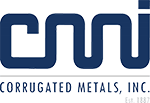On average, a corrugated metal roof can last between 40-70 years. Asphalt shingles, for comparison, are good for around 15-30 years.
Because of their durability – combined with their stylish and low maintenance qualities – metal roofs continue to become an extremely popular choice for residential, commercial, and agricultural buildings.
But as with any new roof, all is good…until it’s not. And from our experience, if something goes wrong, it is almost always traced back to the installation. Let’s take a closer look at the common mistakes that occur when installing a metal roof, and how to avoid them.
Carelessly Recording Measurements
Inaccurate measurements are a significant profit killer in the roofing industry. Failing to measure the roof length and slope correctly causes loose cuts, rough edges, and improper exposure to the elements, leading to rust and roof coating failure.
With a wide variety of thicknesses, shapes and profiles available, no two metal roof panels are the same. Before you begin, review drawings and designs closely and work with the manufacturer to understand how the size and shape of a metal panel can impact measurements. Then “measure twice, cut once” to attain panels that mold to roof contours and provide a weathertight fit.
Be sure to take advantage of the tools your vendor offers to help make accurate specification decisions during purchasing. For example, Corrugated Metal Inc.’s revolutionary new configurator tool enables you to choose from a vast range of corrugated metal roofing and siding products, materials, finishes, and specifications to visually customize and view the exact products and quantities you need before ordering to help make the process seamless and reduce error.
Ignoring Proper Instructions
If the instructions a contractor plans to follow during install don’t match your manufacturer’s weather-tight warranty details, it can lead to improper installation – causing leaks, significant life span reduction, and even potential damage to the entire structure.
For example, have you ever opted for a DIY project, only for the finished result to not turn out as you had expected, requiring you to redo or hire a professional for help? Without set guidelines or tested methods, it’s easy for things to go wrong.
Whether you’re a roofing contractor or installer, the metal roof should be installed according to the manufacturer’s recommended installation details. Failing to do so can lead to these errors:
- Fasteners – When the screws are either too tight, too loose, or off-center, it allows for water to enter at open spots. Fasteners should be tightened so the rubber washer is completely compressed (as a rule of thumb if the washer is splayed out and visible, then the fastener is too tight).
- Flashing – Incorrect attachment and improper sealing of the flashing will allow water to enter between the roofing systems and the roof structure. Double check the roof’s seams are completely sealed and panels lapped correctly.
- Sealant – Sealants and butyl tape are used to seal out water, dirt, and other debris that could compromise a metal roof. If these are damaged, missing, or applied incorrectly, leaks could occur. A sealant should be applied to the underside of the panel or trim where it is shielded from the elements to avoid disintegrating over time.
- Coating – Any damage to the coating increases the risk of rust. If metal roofing material is cut during installation, it leaves an open edge of the metal exposed, which wicks in moisture. This will begin the rusting process immediately. Prevent scuffing and scratching during installation by using proper lifting devices, avoid walking on panels, and use caution to not scrape tools or other sharp objects against the panel.
While many roofs in the industry are similar, most have little intricacies that will vary from system to system. Using a manufacturer that is involved throughout the entire project can help reduce these avoidable mistakes.
Choosing the Wrong Metal Roofing Panel
With so many metal panel options available, it might be tricky to know which one is best suited for your building’s roof. But choosing the wrong roofing materials is a recipe for disaster, plain and simple.
Why?
Not all roof materials are created equal and can create time-consuming and costly situations if ignored. Building with the wrong materials can lead to:
- Water leaks accumulating behind vulnerable points in the roof structure
- Wicking moisture being collected from snow and ice dams
- Holes and cracks forming on the underside of a ceiling
- Continuous roof sheathing problems
- Premature roof deterioration
- Roof rotting from moisture corruption
- Debris being lodged under shingles from high winds
- Moss or algae growth caused by trapped moisture
- Higher energy bills due to poor insulation
Before choosing a roofing material, you must consider important factors like environment, climate, roof slope, etc. to ensure you choose an appropriate option that will be feasible for your project.
Consider working with a trusted supplier like Corrugated Metals Inc. who has over 125 years of industry experience, continuously meets industry standards, thoroughly tests its products, and stands behind them with warranties, to help you make the best decision for your project and cut down on roofing problems.
Do It Right, The First Time
The roof is one of the most important parts of a building; it’s what protects the people as well as the structure itself. That’s why it’s important to be cautious, pay attention to detail, and use quality products when planning a metal roof installation in your next project. Doing things right the first time will save yourself the money, effort, and time of dealing with repairs down the road.
If you’re ready to learn how CMI’s experience and innovation will enhance your next roofing project, get in touch today.

